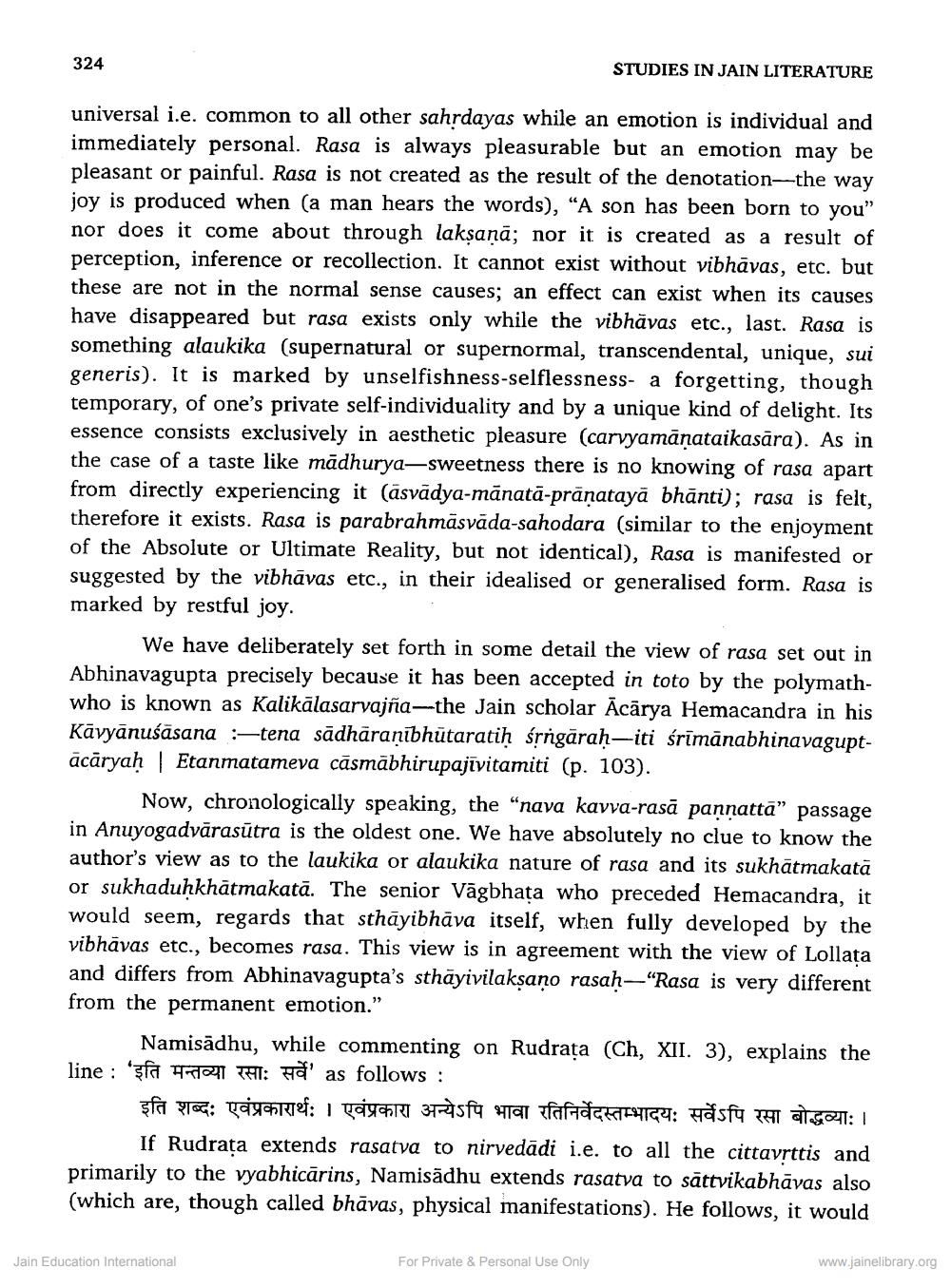________________ 324 STUDIES IN JAIN LITERATURE universal i.e. common to all other sahrdayas while an emotion is individual and immediately personal. Rasa is always pleasurable but an emotion may be pleasant or painful. Rasa is not created as the result of the denotation-the way joy is produced when (a man hears the words), "A son has been born to you" nor does it come about through laksana; nor it is created as a result of perception, inference or recollection. It cannot exist without vibhavas, etc. but these are not in the normal sense causes; an effect can exist when its causes have disappeared but rasa exists only while the vibhavas etc., last. Rasa is something alaukika (supernatural or supernormal, transcendental, unique, sui generis). It is marked by unselfishness-selflessness- a forgetting, though temporary, of one's private self-individuality and by a unique kind of delight. Its essence consists exclusively in aesthetic pleasure (carvyamanataikasara). As in the case of a taste like madhurya--sweetness there is no knowing of rasa apart from directly experiencing it (asvadya-manata-pranataya bhanti); rasa is felt, therefore it exists. Rasa is parabrahmasvada-sahodara (similar to the enjoyment of the Absolute or Ultimate Reality, but not identical), Rasa is manifested or suggested by the vibhavas etc., in their idealised or generalised form. Rasa is marked by restful joy. We have deliberately set forth in some detail the view of rasa set out in Abhinavagupta precisely because it has been accepted in toto by the polymathwho is known as Kalikalasarvajna-the Jain scholar Acarya Hemacandra in his Kavyanusasana :--tena sadharanibhutaratih srngarah-iti srimanabhinavaguptacaryah | Etanmatameva casmabhirupajivitamiti (p. 103). Now, chronologically speaking, the "nava kavva-rasa pannatta" passage in Anuyogadvarasutra is the oldest one. We have absolutely no clue to know the author's view as to the laukika or alaukika nature of rasa and its sukhatmakata or sukhaduhkhatmakata. The senior Vagbhata who preceded Hemacandra, it would seem, regards that sthayibhava itself, when fully developed by the vibhavas etc., becomes rasa. This view is in agreement with the view of Lollata and differs from Abhinavagupta's sthayivilaksano rasah--"Rasa is very different from the permanent emotion." Namisadhu, while commenting on Rudrata (Ch, XII. 3), explains the line : 'sfa H R 7: Ha' as follows : इति शब्दः एवंप्रकारार्थः / एवंप्रकारा अन्येऽपि भावा रतिनिर्वेदस्तम्भादयः सर्वेऽपि रसा बोद्धव्याः / If Rudrata extends rasatva to nirvedadi i.e. to all the cittavsttis and primarily to the vyabhicarins, Namisadhu extends rasatva to sattvikabhavas also (which are, though called bhavas, physical manifestations). He follows, it would For Private & Personal Use Only Jain Education International www.jainelibrary.org




